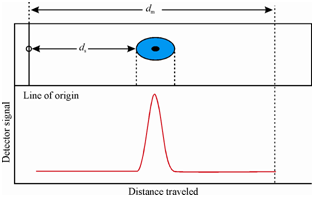Plate Concept Applied to TLC
Plate concept and its terms as developed for column chromatography can be applied to thin layer chromatography after slight modifications. As described in the retardation factor Rf is given by the equation Rf = ds/ dm. In order to adapt, thin layer chromatography with the plate concept, a chromatogram may be visualized as a plot, shown in Figure, where the spot diameter may be considered as width in Eq. Further, ds and dm may be defined in terms of retention time of solute (tr) and retention time of mobile phase (tm), respectively.

Figure: Schematic representation of thin layer chromatogram with plot
For the mobile phase, tm may be defined as the distance divided by its linear velocity, u
tm = ds /u
The solvent does not reach the similar point until the mobile phase has travelled the distance dm. Therefore,
tr = dm /u
Substituting a values of tr and tm in given equation
tr = tm (1 + k′), we get
k′ = (dm - ds)/ ds
The capacity factor k′ can also be expressed in terms of the retardation factor Rf as
k′ = (1 - ds/dm) / (ds/dm) = (1 - Rf)/ Rf
This approach can be used for the method development in column chromatography. It is not easier to calculate capacity factor by thin layer chromatography but it is more rapid than obtaining it from column chromatography experiment. Also, this can be used for calculating the plate height by first determining the number of plates as follows:
N = 16 (ds / w) 2
Where w is the spot width as shown in Figure. Thus, the plate height H is represented by
H = dm /N